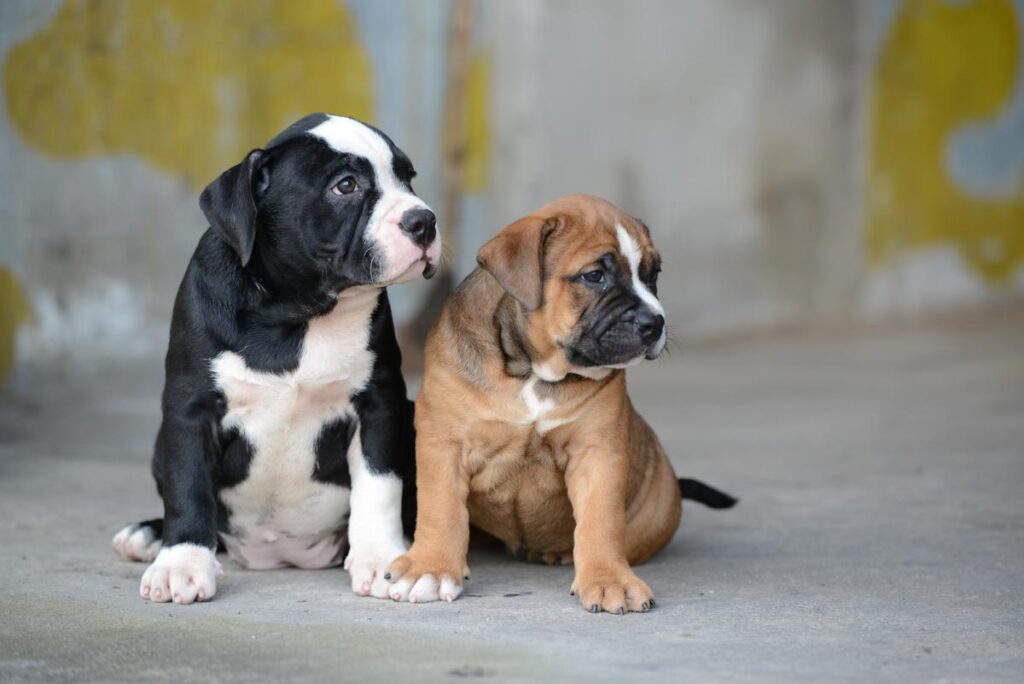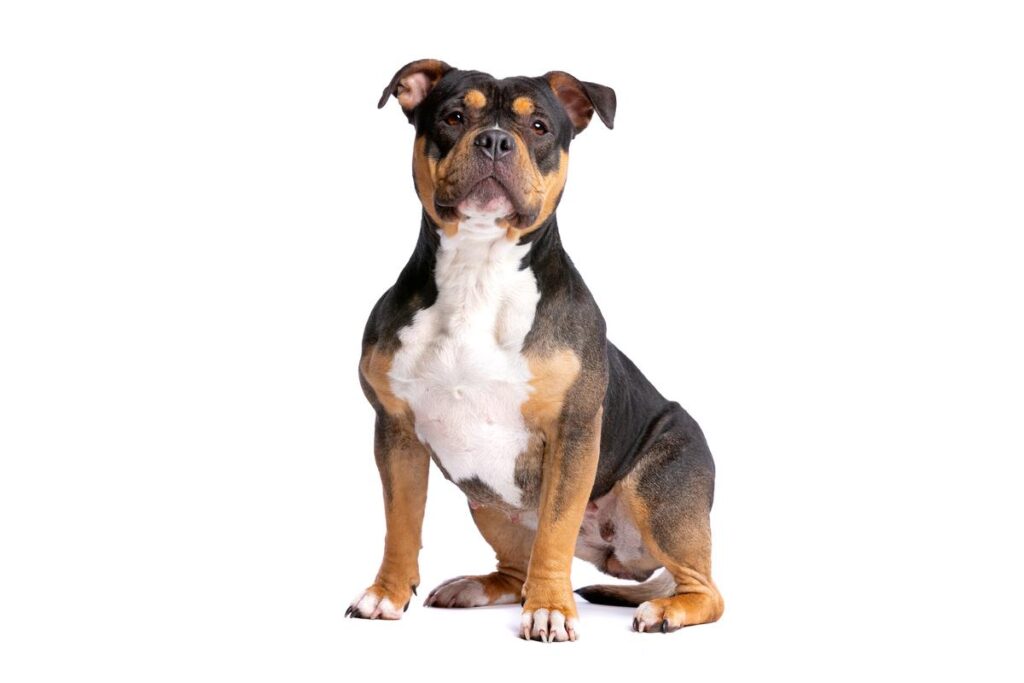Tri Color Bully: A Striking and Strong Companion
A tri color bully is a unique patterned bully dog with three beautiful colors, which makes them unique among solid colored and two colored bullies. These colors are the result of crossing between unique colored bullies. They are also known by different names because of their colors, like tri colored bully, tri bully, bully tri color, tri color American bully, etc.
They are highly trainable and intelligent dogs with a very calm nature. They are also known for their high energy and physical activities. They have strong bodies and need a lot of exercise to fulfill their exercise needs.

So, if you are thinking about the addition of a tricolor bully in your life, keep in mind all the information and their needs, which you can easily understand after reading this guide.
Photos of the tri bully
History of the tri color American bully
As their name shows, they are basically American bullies with different coat colors and unique patterns, so let’s take a look at the history of American bullies first. They were first recognized in the 19th century as a combination of the American pit bull terrier and the American Staffordshire terrier.
The combination of these two wonderful breeds gives results that have muscular bodies with a calm nature and loyalty. Because of this mixture, they came in a variety of colors and patterns, one of which is the tri-color bully.
Appearance of the bully tricolor
| Appearance Aspects | Bully Tri Color |
|---|---|
| Coat Color | Tri-colored pattern, often including white, black, and tan. |
| Coat Texture | Short, dense, and smooth coat; lies close to the body. |
| Coat Patterns | Tri-color combination varies, with distinctive markings. |
| Body Structure | Muscular build with a stocky and sturdy physique. |
| Head Shape | Broad and blocky head with well-defined jawline. |
| Eyes | Varies based on breed; typically medium-sized and expressive. |
| Nose Color | Varies based on coat color; may match coat markings. |
| Ears | Often medium-sized, set high and can be erect or semi-erect. |
| Tail | Varies based on breed; often short and tapered. |
| Size | Medium to large size, with varying heights and weights. |
| Muscle Tone | Well-developed muscles, especially in shoulders and chest. |
| Bone Structure | Strong and substantial bone structure. |
| Movement | Confident and purposeful gait; moves with power. |
| Expression | Often displays a friendly and alert expression. |
| Teeth and Bite | Strong jaws with a regular scissor bite. |
| Markings and Patches | Tri-color markings can be symmetrical or irregular. |
| Wrinkles (if applicable) | Some breeds may have loose skin and wrinkles. |
| Size Variability | Different bully breeds vary in size and proportions. |
| Ear Shape | Varies by breed; can be rose, button, or cropped. |
| Tail Shape | Varies by breed; can be straight or docked. |
| Paw Size | Often has sturdy, well-padded paws. |
| Body Proportions | Square or slightly rectangular body proportions. |
| Expression Variability | Some may have an intense or serious expression. |
| Coat Glossiness | Often has a glossy sheen to the coat. |
| Eye Shape | Typically almond-shaped eyes; varies by breed. |
Coat
Bully tri colors have a shiny and smooth coat that can be maintained very easily. They have short and straight hair. They are non-hypoallergenic and shed a lot. So, if you are allergic to their hair, it’s a little tough to have them.
Color
As their name shows, they have three different colors, which vary in almost every individual because of mutations in their genes. They also have different patterns that are prominent near their ears. They mostly contain Black, blue, chocolate, and little brown colors with white or tan markings on their lower sides.

Body
Tri colored bullies have the same physique as American bullies. They have a big head, which is wider than that of normal dogs. They also have prominent jaws, which showcase their sharp teeth. Tricolored bullies have short ears that have cuts. They have wide brown or black noses with prominent mustaches.
They have a strong body with prominent muscle cuts, which showcase their power and give them a strong dog look. They have strong legs, which add some inches to their height and give them a fully bully dog look.
Eye color
They have different eye colors, like black, brown, or blue. Blue is common in them, and sometimes they have different colors in both eyes.
Weight and size
Tri color bully is found in four different sizes.
| Size | Weight | Height |
| Pocket size | 20 to 25 pounds | 14 to 17 inches |
| Classic bully | 50 to 70 pounds | 17 to 20 inches |
| Standard bully | 60 to 85 pounds | 17 to 20 inches |
| XL bully | More than 85 pounds | 20 to 23 inches |
Age of the tri colored bully
Thanks to their parent breed, they live a healthy life and spend a good 10 to 13 years. Sometimes they have to face some health problems because of their owner’s negligence; otherwise, they live a healthy life.
Liter size of the tri bully
Their liter size is lower than other dogs; they produce 4 to 5 puppies in their adult age. Their liter size also varies with their age and health.

Behavior of the bully tri color
Bully tri colors are also known for their good behavior and obedient nature. They are very attached to their owner and remain faithful until their death. They are always ready to protect their owner from any danger and also protect their property and family.
| Behavior Aspects | Bully Tri Color |
|---|---|
| Temperament | Generally loyal, affectionate, and protective. |
| Sociability | Typically friendly and social with proper socialization. |
| Playfulness | Often enjoys interactive play and games. |
| Energy Levels | Varies by breed; can be moderate to high energy. |
| Aggression | Generally not aggressive if properly trained and socialized. |
| Separation Anxiety | May experience separation anxiety if not accustomed to being alone. |
| Barking | May bark to alert or communicate, but not excessively. |
| Digging | Some breeds may dig occasionally, especially when bored. |
| Chewing | Puppies may chew during teething; provide appropriate toys. |
| Jumping | May jump when excited; training can curb this behavior. |
| Dominance | May display dominance tendencies if not properly trained. |
| Territorial | Can be territorial if not socialized early. |
| Prey Drive | Varies by breed; some may have higher prey drive. |
| Aggression to Dogs | Generally social if socialized properly as a puppy. |
| Aggression to Strangers | May be cautious or wary of strangers; socialization helps. |
| Aggression to Animals | Socialization and training can reduce aggression toward animals. |
| Aggression Triggers | Early socialization helps prevent aggression triggers. |
| Fearfulness | Proper socialization can reduce fearfulness. |
| Trainability | Generally intelligent and responsive to training. |
| Guarding Behavior | Some may display guarding behavior; training is important. |
| Destructive Behavior | Boredom can lead to destructive behavior; provide mental stimulation. |
| Vocalization | May bark, whine, or howl to communicate. |
| Territorial Behavior | May mark territory, especially if not neutered. |
| Social Interaction | Enjoys interaction with humans and other dogs. |
| Adaptive Behavior | Can adapt to different environments with proper training. |
They are very good watchdogs and notice everything that happens to them. They also take care of flocks of sheep or cows in the absence of their owner and help him with their maintenance.
They are always full of energy and great with children. They love fetching things in the garden or playground. They easily divert everyone’s attention towards them, and they love to attain attention by showing different tricks and running after the balls.
Also Read: Big Rope French Bulldog – Ultimate Guide
Training of the Tri Colored American Bully
| Training Aspects | Bully Tri Color |
|---|---|
| Training Temperament | Generally intelligent and eager to please. |
| Socialization | Early and consistent socialization is crucial. |
| Obedience Training | Responds well to positive reinforcement methods. |
| Consistency | Requires consistent training routines. |
| Positive Reinforcement | Responds best to rewards and praise. |
| Patience | May require patience during training sessions. |
| Basic Commands | Can learn basic commands quickly with practice. |
| Complex Commands | Capable of learning more advanced commands over time. |
| Leash Training | May pull initially; leash training is important. |
| Crate Training | Generally adaptable to crate training when introduced early. |
| Clicker Training | Responds well to clicker training for specific cues. |
| Behavior Correction | Effective correction techniques without harshness. |
| Mental Stimulation | Enjoys training that engages their mind. |
| Training Environment | Requires a quiet and distraction-free environment for focus. |
| Agility Training | Can excel in agility activities with training. |
| Social Training | Positive interactions with other dogs are important. |
| Recall Training | Consistent recall training is crucial for safety. |
| Trick Training | Enjoys learning new tricks and tasks. |
| Training Challenges | May test boundaries; consistency is key. |
| Professional Help | Consider professional training for complex behaviors. |
| Training Equipment | Proper collars and harnesses for safe training. |
| Training Time | Short, frequent training sessions are effective. |
| Training Rewards | Utilize treats, toys, and praise as rewards. |
Just like bullies, tri-colored American bullies are very intelligent and can be easily trained at any age. But starting their training at an early age helps the pup and their master a lot. They get their basic training very easily, like eating in a fixed place, potty training, and understanding short sounds like sit or go.
Start their training by giving them little healthy treats or their favorite toy after listening to your every command. Always remember to give them a treat on the spot; if you delay it, it will not connect with your commands, so do not give the same response next time.
Grooming of the tri color bully

Care Aspects for the Bully Tri Color breed
| Care Aspects | Bully Tri Color |
|---|---|
| Grooming | Regular brushing to minimize shedding and maintain coat shine. |
| Exercise Needs | Moderate to high; regular exercise to prevent weight gain. |
| Diet & Nutrition | Balanced diet with high-quality proteins; portion control. |
| Health Considerations | Watch for breed-specific health issues; regular vet visits. |
| Socialization | Early and positive socialization for well-adjusted behavior. |
| Training | Positive reinforcement training for best results. |
| Energy Levels | Varies based on breed; some are more active than others. |
| Intelligence | Moderate to high; generally easy to train. |
| Family Compatibility | Generally good with families and children if properly trained. |
| Living Environment | Indoor living with regular outdoor exercise; climate considerations. |
| Vocalization | Some breeds are more vocal than others. |
| Loyalty | Strong bond with owners; often protective of family. |
| Playfulness | Varies by breed; many are playful and enjoy interactive activities. |
| Adaptability | Some breeds may adapt better to different living situations. |
| Exercise Variety | Enjoys various activities; from walks to playtime. |
| Sociability | Generally friendly with other dogs if socialized early. |
| Training Challenges | Some may be stubborn; consistency is key in training. |
| Space Requirements | Needs sufficient indoor space and outdoor play area. |
| Coat Maintenance | Low-maintenance coat, but regular cleaning still needed. |
| Allergies | Some breeds may be more prone to allergies. |
Bathing
Tri Bullies have short hair, which is considerably low maintenance, and do not need a lot of grooming and care, but as we know, they have a lot of physical activities, so their coat gets a little dirty during training and other activities, so you have to give them a bath once a week or depend on their regular hygiene. Always use good dog shampoo for their bathing. Regular human shampoo is not for your dog; it causes allergies and irregular dryness in their body.
Brushing
Bully breeds are good shedders, and they shed a lot throughout the year. Tricolored bullies also shed a lot, but they have short and smooth hairs, which make their brushing easy and smooth. You can easily take care of their dogs by giving them five to 10 minutes and they are ready to go.
Trimming
Tri color American bullies do not need a lot of trimming for their hair because they already have short hair, which can be easily managed without trimming or giving them once every six months.
They need trimming on their nails because they grow very quickly and are a little dangerous for children. Their nails also cause scratches and sometimes serious injury to their coat if they are not trimmed regularly and firmly.
Ear cleaning
Bully tricolors have small and straight hairs, which is why they get wax very easily, which can cause ear problems and need to be cleaned regularly.
Breed characteristic summary of the bully tri color
| Characteristic | |
|---|---|
| Size | 13 to more than 23 inches |
| Weight | 20 to more than 85 pounds |
| Life Span | 8 to 13 years |
| Coat | Short, shiny, and non-hypoallergenic |
| Color | Black, blue, chocolate, or little brown with white or tan markings on their lower side. |
| Temperaments | Friendly, calm, and loyal |
| Intelligence | Very intelligent |
| Socialization | They mostly love to stay around their family. They have average socialization abilities. |
| Destructive Behavior | If they are not trained at an early age, they will be a little aggressive and obsessed with their owner. |
| People Skills | They are good watchdogs, so they bark when they see any strangers around them. |
| Behavior with children | Great with children and spend time with them. |
| Behavior with other animals and dogs | Average with unknown animals, but if any animal lives in their house, they are protective of him. |
| Exercise | Need a lot of exercise and other physical activities. |
| Liter Size | 4 to 5 puppies |
FAQs
How much is a tri color bully?
Tri color bullies are gaining fame among dog owners with their unique patterns and colors, so they are a little expensive. You have to spend 4,000 to 5,000 dollars for this breed. Their price varies with different factors, like if you are living in an area where this breed is not recognized yet and does not have a lot of popularity, you will have to spend some more dollars for their boarding and care.
How much is a tri color bully worth?
Tri color American bully is very intelligent dog and you do not feel any regret after their addition in your family you just have to spend 4,000 to 5,000 dollars.
How do I get a tri color bully?
If you are breeding two tri color bullies to get American tri color bully, it doesn’t mean you get results according to your wishes because their tan point gene is a recessive gene that does not appear in all offspring. For having these colors, one parent must be a tri color, but if the other parent has a solid color on it, there will be more chance to get tricolor offspring in good quantity.
How do you make a tri color American bully?
Their three colors came because of the tan point allele, which appears in some puppies because it is a recessive gene and does not appear in all offspring. This gene comes from the Agouti locus of the American pit bull terrier, and usually solid colors have dominant genes, so they appear in most of the puppies. You can trace the gene using genetic or DNA testing methods to get results according to your requirements.
Final Thoughts
Tri color bully have all the qualities of American bullies, but in addition, you get a unique three color shinny coat. This dog gets its identity from its coat color, which comes in some different colors and patterns but is mostly tan or white.
Their behavior made them good, energetic family members who want everyone’s attention and just want to amaze them with their intelligence level and happy temperament. They are also very good with children and can keep them busy for a long time because this breed is just like little children, whose energy level never comes down and they are always ready to play.





